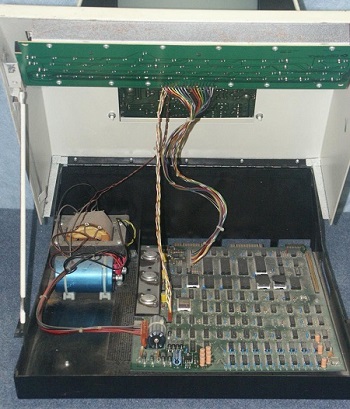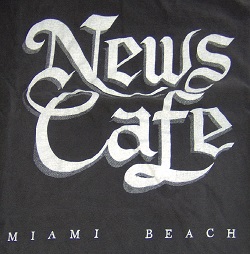60-Plus Years of Analysis
No, It's Probably Not What You're Thinking
Although I have no doubt that there are some people who have undergone "analysis" for that period, I'm definitely not one of them. However, I have been analyzing spectra, one way or another, for that long. My first spectrum analyzer was a "panadapter" for my ham radio back in the early '60s. In the late '60s it was my privilege to work for the late Federal Scientific Corp., one of the pioneers of realtime spectrum analyzers. In my early work at Eventide the Hewlett-Packard 3580A was a necessary tool for designing and troubleshooting our recording and broadcast audio products. When eBay made such previously unthinkable extravagance possible, I collected spectrum analyzers, only some of which were included in my "Beauty Pageant" blog of 2006. Today, my "go to" analyzer is the redoubtable Agilent 89441A, which covers almost-DC up to 2.6GHz with remarkable sensitivity and precision.
There's Something Missing From The Above Chronology
Although I've used all the analyzers mentioned, I didn't mention the unique one that I created and designed from scratch. How unique? So much so that I believe it was the first instrument ever incorporated inside a general purpose computer. Am I certain? No, of course not. But before this product, instruments were invariably connected to computers, not part of them. This, another of our Eventide 50th-anniversary Flashback series, is the story of the "THS224" spectrum analyzer for the Commodore PET.
The Commodore PET*
The Commodore PET was the first true "personal computer," pre-dating the Apple II, the Radio Shack TRS80, and the IBM PC. The original version used a cassette tape for program storage and had a so-called "Chicklet" keyboard! But most importantly, it sported very little memory and a yawning chasm of a chassis. You'll recall from our previous flashbacks that Eventide feasted on memory, and whenever a new generation came out, we found a way to, using today's jargon, "monetize" it. The PET was too good an opportunity to waste! It sold over 100,000 units and every one of them needed more than the 4k or 8k static memory that came from the factory. We found a way to add the much cheaper dynamic memory to factory units, dubbed the 16k and 24k cards "BIG MEM," and sold them for what must have been considered a reasonable price in the late '70s.
 |
The main circuit board of the PET had vastly more space above it than needed for a second board. Unlike today's compact hardware and flat screens, this computer had a heavy, bulky chassis with a deep CRT display assembly on top. Our Big Mem boards, which took little space were the first, obvious addition to the PET. We had the notion of manufacturing a spectrum analyzer before the PET was introduced. But it would have been a major project for the tiny company we were in the '70s. It would have required not just the analyzer circuitry, but also the power supply, metalwork, controls, CRT, and cosmetic embellishments that make a product stand out. And we might have had to embed one of the new microprocessor chips in the circuitry, too, if we wanted it to be more than a very simple device. When we got our first PET and saw how much of the spectrum analyzer was already there, we heard the call of the unused space. It whispered "use me!" You don't hear that a lot nowadays. The Big Mem memory board was what is now called a "no-brainer." Took a few days to design, didn't require any software beyond a memory test program, and used the same parts we used in some of our other products. |
The Spectrum Analyzer Wasn't Quite As Easy
True, the hardware practically designed itself. In the case of a 1/3-octave analyzer, all that was required was a bank of simple filters with the appropriate center frequencies, an amplifier to apply audio to all of the filter inputs, and a multiplexer to measure the output voltage of each, which depended on the amplitude and audio frequencies of the input signal. Plug it into the same connector that our memory boards used, and there it was!
Here it is: The circuit board artwork was found in the deep recesses of a cabinet with really large, thin drawers that drafting departments used before paper became obsolete. It was made from red and blue tape from Bishop Graphics, which allowed photographic separation. (How did the product get its model number? The tape came with dots, lines, component pads, and letters in different sizes. We called it the "THS224" because those letters were left over.) So, making a spectrum analyzer is not that big a deal, eh? Well, not exactly. Unlike a memory board, you can't just connect a spectrum analyzer hardware assembly and expect a useful display. No, software was required!** |
This wasn't exactly my first programming experience. I had written a program for the Motorola 6800 microprocessor that, along with a special interface chip, would allow a computer to adjust the delay settings on the 1745M Digital Delay Line. But writing a program that would analyze and display signals on the PET CRT was an order of magnitude more complicated. The Mostek 6502 processor used a less-than-pellucid addressing scheme, at least to my hardware-oriented brain. And once the programming was done, one had to turn the computer itself into a product the user could employ. A few odd tasks that had to be performed:
- Create a "user interface." Since the PET had only a keyboard and no knobs or switches as did true instruments, the keys had to be used. We used a Hewlett-Packard plotter to create a keyboard overlay using multiple ink colors*** to identify keys and their functions. We laminated the overlays with a machine bought from an office equipment supplier.
- Create a method of program distribution. Most of the code was on an EPROM on the analyzer board, but to get started, you needed to use a tape cassette. Not exactly a reliable computer medium.
- Provide a manual. Unlike today's one-page, confusingly illustrated instructions with a web link, we used "paper" and "words," usually spelled correctly and in the proper order. The manual was even more of a challenge than one might think, since the PET had no way of printing the graphics on the screen, and photographic film was a non-starter for a number of reasons. We first replicated the PET's goofy graphics character set on a different, more professional computer that could print graphics. Then, using the remarkably useful "PEEK" and "POKE" instructions in PET BASIC, copied the character codes from the PET to the other computer, which then used the codes to generate the graphic characters that replicated those on the PET screen. I go on about this at some length because I think I remember spending more time on the manual than on the product itself. Download a copy if you're keen to see the results of all that work.
If you've read this far but only have a vague notion of what the THS224 Spectrum Analyzer does (well, did), do take a look at the manual. The analyzer was a pioneering product in many ways. Shortly after it was introduced, we "leveraged" work on the hardware to create additional models for the then-new Apple II and the Radio Shack TRS-80. The Apple version in particular benefited from a new employee, Steve Hoge, who actually could write software even then. We offered a product called "Specsystem" that produced far more analytical information from the hardware than did the original program.
Is It Disco?
Since Eventide was (and remains) a professional audio company, we thought it would be fun to have a contest involving the analysis of music. Disco was a thing at the time, and, coincidentally, Eventide was then located across the street from the notorious Studio 54. The PET spectrum analyzer would, we reasoned, allow one to pick out the beat characteristics of the audio input and declare the song producing that beat to be innocent or guilty of committing premeditated disco. Sadly, not enough of our units were in the hands of creative analysts, and the contest produced no winners.****
Is This a Flashback?
Yes, it is. I edited this version to make it Eventide's 50th Anniversary Year Flashback #10. The "official version" is less personalized and much prettier!
* Of course it was an acronym. "Personal Electronic Transactor"
** Back in the '70s, one "programmed computers." Now one "writes software." I never learned the latter, but I did develop some facility with assembly language for Motorola and Mostek microprocessors, along with teaching early Hewlett-Packard computers to do some useful tricks.
*** Of course we could have used a color ink-jet or laser printer. If the ink jet had been invented by then, or if color laser printers existed.
**** Or entries. Probably anyone who tried to enter had to listen to too much disco and, well...


